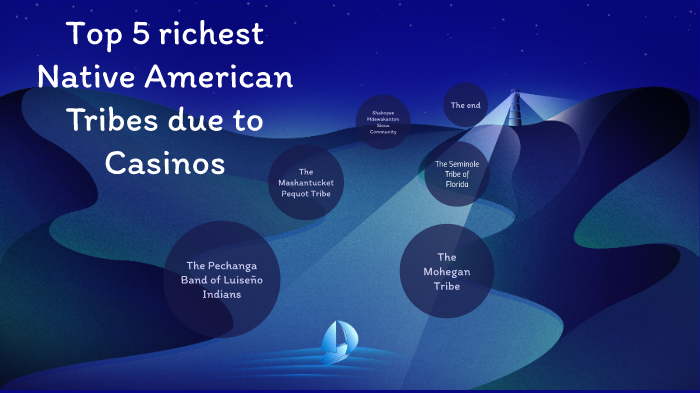The Richest Tribes in America: A Look at Wealth, Sovereignty, and Economic Development
The Richest Tribes in America: A Look at Wealth, Sovereignty, and Economic Development

The United States is a land built on the backs of Native American tribes, yet their historical struggles and ongoing challenges often overshadow the remarkable success stories of some of these communities. While many tribes face poverty and limited opportunities, others have emerged as economic powerhouses, demonstrating resilience and innovation in managing their resources and building thriving economies.
This article delves into the world of the wealthiest Native American tribes in the United States, exploring the factors that contribute to their success, the challenges they face, and the impact their wealth has on their communities and beyond.
Related Articles: The Richest Tribes in America: A Look at Wealth, Sovereignty, and Economic Development
- Unveiling The Wealth Of Indigenous Nations: Exploring The Richest Indian Tribes In The United States
- The Richest Tribes In America: A Look At Wealth And Sovereignty
- Unveiling The Riches: Exploring The World’s Wealthiest Tribes
- Unveiling The Meaning Behind Wampanoag Names: A Journey Through History And Culture
- Uncovering The Wealth Of Washington’s Indigenous Nations: Top 10 Richest Tribes
The Legacy of Sovereignty and Self-Determination
Understanding the wealth of Native American tribes requires acknowledging their unique status as sovereign nations within the United States. This sovereignty grants them the right to self-govern and manage their own affairs, including their land, resources, and economic development. This autonomy has been crucial in allowing some tribes to pursue economic opportunities and build wealth.
The Pillars of Economic Success
Several key factors contribute to the economic success of the wealthiest Native American tribes:
- Gaming Revenue: The legalization of gaming on tribal lands in the 1980s revolutionized the economic landscape for many tribes. Casinos, particularly in states like California, Nevada, and Oklahoma, have generated substantial revenue, allowing tribes to invest in infrastructure, education, healthcare, and social programs.
- Natural Resources: Many tribes possess valuable natural resources, such as timber, oil, gas, and minerals. These resources provide significant income streams and have enabled tribes to establish their own energy companies, mining operations, and forestry businesses.
- Entrepreneurship and Innovation: Tribes are increasingly embracing entrepreneurship, establishing businesses in various sectors, including hospitality, tourism, agriculture, and technology. These ventures create jobs and stimulate economic growth within tribal communities.
- Investment and Financial Management: Successful tribes have invested wisely in financial markets, real estate, and other assets, building diversified portfolios that generate long-term wealth.
- Government Contracts: Some tribes have secured lucrative government contracts, particularly in areas like construction, energy, and technology, further bolstering their economic standing.

The Top 10 Wealthiest Native American Tribes
While ranking tribal wealth is complex due to varying accounting practices and lack of public financial data, here are some of the most economically successful Native American tribes based on available information:

- Cherokee Nation: The Cherokee Nation, based in Oklahoma, is one of the largest and wealthiest tribes in the US. Their economic success is largely attributed to their successful gaming operations, energy ventures, and diversified business holdings.
- Chickasaw Nation: The Chickasaw Nation, also in Oklahoma, boasts a robust economy driven by gaming, healthcare, and energy. Their focus on education and community development has resulted in significant improvements in the lives of their members.
- Navajo Nation: The Navajo Nation, spanning parts of Arizona, New Mexico, and Utah, is known for its vast natural resources, particularly coal and uranium. While facing environmental challenges, the tribe has leveraged these resources to generate substantial revenue.
- Seminole Tribe of Florida: The Seminole Tribe of Florida has become a major player in the gaming industry, with its successful casinos generating significant income. They also own and operate businesses in various sectors, including hospitality and agriculture.
- Citizen Potawatomi Nation: The Citizen Potawatomi Nation in Oklahoma has built a thriving economy based on gaming, energy, and business ventures. Their focus on community development has improved the quality of life for their members.
- Mohegan Tribe: The Mohegan Tribe in Connecticut is renowned for its successful gaming operations, with its casino generating significant revenue. They have also invested in other businesses and real estate, further solidifying their economic position.
- Mashantucket Pequot Tribe: The Mashantucket Pequot Tribe in Connecticut is known for its iconic Foxwoods Resort Casino, one of the largest casinos in the world. Their success in the gaming industry has fueled their economic growth.
- Turtle Mountain Band of Chippewa Indians: The Turtle Mountain Band of Chippewa Indians in North Dakota has a diversified economy based on gaming, energy, and agriculture. They have also invested in businesses and real estate, contributing to their economic success.
- Odawa Indians of Michigan: The Odawa Indians of Michigan have seen significant economic growth through their successful gaming operations, particularly their casino in Petoskey. They also have investments in other businesses and real estate.
- Sac and Fox Nation: The Sac and Fox Nation in Oklahoma has leveraged its resources and entrepreneurial spirit to build a strong economy based on gaming, energy, and other business ventures.

Challenges and Opportunities
Despite their economic achievements, the wealthiest Native American tribes face unique challenges:
- Economic Diversification: Many tribes rely heavily on gaming revenue, which can be volatile and subject to market fluctuations. Diversifying their economies into other sectors is crucial for long-term stability.
- Infrastructure Development: Many tribal communities lack access to adequate infrastructure, including roads, water systems, and broadband internet. Investing in infrastructure is essential for attracting businesses and fostering economic growth.
- Environmental Challenges: Some tribes, particularly those with significant natural resources, face environmental challenges related to resource extraction and pollution. Balancing economic development with environmental protection is crucial.
- Social and Economic Inequality: Despite the success of some tribes, many Native American communities continue to face poverty, unemployment, and lack of access to education and healthcare. Bridging the gap between wealthy and less-wealthy tribes is essential for overall Native American economic prosperity.
The Impact of Tribal Wealth
The wealth of Native American tribes has a profound impact on their communities and beyond:
- Improved Quality of Life: Tribes have invested their wealth in education, healthcare, housing, and social programs, significantly improving the quality of life for their members.
- Economic Development: Tribal businesses and investments create jobs and stimulate economic growth within tribal communities and surrounding regions.
- Cultural Preservation: Financial resources allow tribes to invest in cultural preservation efforts, including language revitalization, art programs, and historical preservation projects.
- Self-Determination and Sovereignty: Economic success strengthens tribal sovereignty and allows them to exercise greater control over their destiny.
Conclusion
The wealthiest Native American tribes are testaments to the resilience, innovation, and entrepreneurial spirit of these communities. Their success stories demonstrate the power of self-determination and the importance of managing resources wisely. While challenges remain, these tribes are paving the way for a brighter future for Native Americans, not only through economic prosperity but also through cultural preservation and social progress.
FAQ about Wealthiest Native American Tribes
Q: How are Native American tribes considered sovereign nations?
A: Native American tribes are considered sovereign nations due to treaties and agreements made with the U.S. government, recognizing their inherent right to self-govern and manage their own affairs.
Q: Why do some tribes have casinos while others don’t?
A: The Indian Gaming Regulatory Act of 1988 allows tribes to operate casinos on their land if state governments agree. Some states are more supportive of tribal gaming than others.
Q: Are all Native American tribes wealthy?
A: No, not all Native American tribes are wealthy. Many tribes face poverty, unemployment, and limited access to resources. The wealth disparity among tribes is significant.
Q: How do Native American tribes use their wealth?
A: Tribes use their wealth to invest in education, healthcare, housing, infrastructure, economic development, cultural preservation, and social programs for their members.
Q: What are some of the challenges facing Native American tribes?
A: Challenges include economic diversification, infrastructure development, environmental protection, social and economic inequality, and combating poverty and unemployment.
Q: What is the future of Native American tribes?
A: The future of Native American tribes is bright, with many tribes leveraging their resources, innovation, and entrepreneurial spirit to build a better future for their communities. However, overcoming challenges and ensuring equitable access to opportunities for all Native Americans is essential for long-term progress.
Closure
Thus, we hope this article has provided valuable insights into The Richest Tribes in America: A Look at Wealth, Sovereignty, and Economic Development. We appreciate your attention to our article. See you in our next article!



